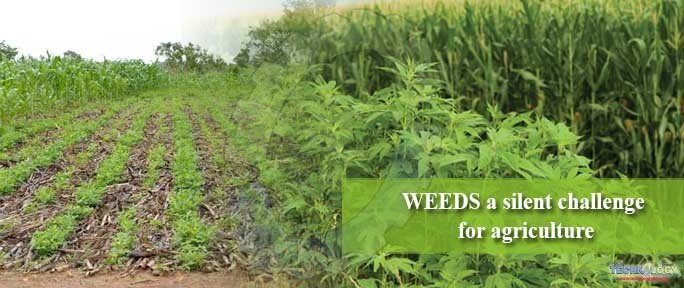Weeds are major biotic limitation towards food production. Weeds compete with crops for the same resources, principally water, nutrients, light and carbon dioxide.
 Weed-Crop competition decreases agricultural output; quantity and quality and increases peripheral costs by scattering them across farm confines.
Weed-Crop competition decreases agricultural output; quantity and quality and increases peripheral costs by scattering them across farm confines.
Weeds possess great challenge in the cultivation of commercial crops and effecting yield. According to recent research Harmful insects, diseases and others upto 30%, 20% and 5%, respectively but weeds alone count for 45% reduction in per acre crop yield.
According to Ayub Agricultural Research Institute, Faisalabad weeds cause reduction in yield of Wheat 18-30%, Cotton 13-41%, Rice 17-39%, Sugarcane 10-35%, Maize 24-47%, Pulses 25-55%, Oilseed Crops 21-45% and in Vegetables 39-89%. Weeds not reduced the yield of crops but effects the quality as well.
Water loses by weeds
Weeds used the water that is already present in soil or artificially applied water which is continuously diminishing now a days; by transpiring or by using for growth and development; the same water which could be utilized by crops, humans and animals also.
Weeds with respect to crop plants used water rapidly and sucks water from deep in the soil. According to research chaulai plant in one day 56.11 ml, bhakra 54.14 ml, wild oat 30.92 ml water transpire, so in an acre weeds wastes almost 2.5 lac liter water in one day.
Competition for Nutrients
Nutrients, water and light are the basic requirements for all the growing plants. The requirements for weeds are similar to those for crop plants and when the two overlap in space they compete for one or more of these resources.
Competition for limited resources will lead to reduced crop yield and of ten lowered quality. Frequently more than one factor may be involved in competition between weeds and crop.
Weeds, for example, may be better competitors for soil nutrients than the crop, resulting in robust weeds that are better able to compete for light and moisture as well.
According to research from one hectare field of wheat up to 52 kg Nitrogen, 12 kg phosphorus and 52 kg potash is utilized by weeds and wasted.
Competition for Light
All the plants required sunlight to produce food. Weeds are also plants so they strongly compete with crop plants for sunlight and weeds are able to grow fast as compared to crop plants and mature earlier than crop.
So it creates hurdles in growth and development of crop plants by competing for light and forms shade on growing plant. According to some idea, weeds stops up to 95% sunlight and only 5% sunlight is available for crop plants thus dropping the food producing capabilities of crop plants.
Low Quality Produce
Weeds is not only responsible for lowering the yield but reduces the quality as well. So farmers gets low price in the market and sometimes Bupari refuse to purchase the crop.
Competition for Space
Weeds compete for space both in the rhizosphere and atmosphere. Weeds grow rapidly and cover all the free space and convert productive land into forest within no time so on that land it is impossible to grow crops.
According to an idea, Cotton plant covers the 95-100% soil surface in 13 weeks but important weeds covers the same soil surface in 5-9 weeks.
Host for Harmful Insects
Weeds act as host for harmful insect-pests and diseases. Weeds hide the nourishing insects in off season, so insects complete their life cycle and in the start of growing season mature insects attack on crop plants and harm the crops. For example Itsit and Bathu are the host plants for armyworms which damage the crops.
Health Problems
Weeds can also cause health problems in humans. Many common weeds such as Parthenium Weed, Dhatura, Ragweed and Rye Grass cause asthma and other respiratory problems, especially in children. Some weeds are also the source of allergic pollens which cause skin irritation and certain are noxious.
Weeds are posing severe threats to Pakistan’s natural environment and primary production industries. They shift inborn species, subsidize considerably to land deprivation, and decrease farm and forest efficiency.
Weeds normally produce huge numbers of seed, accompanying their spread, and quickly occupy disturbed places. Seeds spread by means of airstream, channels, public, vehicles, equipment’s, birds and other animals into natural and disturbed environments.
Approaches to Control
- Get to identify the native weeds in your area. Contact your weed officer, Land care group or agronomist.
- Be aware that weed seeds are transported on vehicles, trailers, clothing, and shoes, in soil and in pet or livestock fur and hair.
- Always follow the selected tracks when walking, horse-riding, driving, or riding-motorbikes through natural areas.
- Dispose of weeds that are already seeding or readily able to reproduce vegetatively by placing them in a black plastic bag, sealing it and “roasting it” in the sun until destroyed. This method alone may not kill all parts of the weed, for example bulbs, and may need to be used in combination with other methods such as mulching. If not confident, contact an expert for advice.
- Compost or dispose of other garden and green waste in waste collections or by carefully transporting it to far areas.
- Always cover trailers when transporting plant material to prevent seeds and other live plant material falling off.
- Carefully select what plants you buy for ponds.
- Never dump aquarium water into waterways or in arable lands.
Author: Muhammad Rehan Saleem, Muhammad Shafique, Zain Ul Abidin, Zubair Majeed